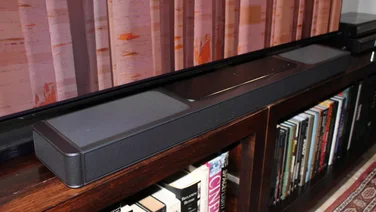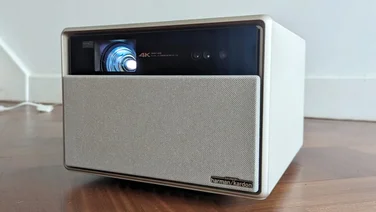To help us provide you with free impartial advice, we may earn a commission if you buy through links on our site. Learn more





- Dazzling clarity and colour performance
- Surprisingly good audio
- Stupidly simple to set up
- Lacks key streaming services
- Occasional outbreaks of soap opera effect
- Not bright enough for daytime use
The Horizon S Pro arrives just 18 months after the launch of XGIMI’s Horizon Ultra, which to this day remains one of our all time favourite home cinema projectors.
Its image quality is impeccable and its sound impressive, and it’s a beautifully designed piece of home entertainment kit. Yet the Horizon Ultra it’s in danger of being replaced in my affections by this new successor. The Horizon S Pro gives you most of what’s great about the Horizon Ultra, but for just under £1,200.
What do you get for the money?
The XGIMI Horizon S Pro is a 4K home cinema projector with 1,800 ISO lumens of brightness and an integrated stand. It comes with XGIMI’s Intelligent Screen Adaption (ISA) tech for automated alignment, anti-keystoning and focus and includes built-in Android TV streaming plus Harman Karmon sound.
As with most budget 4K projectors it uses pixel shifting technology to simulate a 4K image from what’s actually a 1080p native resolution. However, the simulation is so effective that you’d be hard pressed to notice any difference, at least not without A/B comparisons and some hyper critical pixel-peeping.
Like the Horizon Ultra, it uses a combination of LED and laser light sources to combine the sharp contrast of laser with the slightly softer tones and more nuanced colours you sometimes get with LED. And it supports the Dolby Vision, HLG and HDR10 high-dynamic range standards.





XGIMI has also retained most of the design features of the more expensive model. The casing is now a tough, textured plastic rather than cream PU leather, but it looks just as stylish. The fabric section on the front still slides down smoothly when you turn the projector on, then slides back up when you turn it off to protect the lens. It’s very compact, too, with a 273 x 174mm footprint and a height of just 234mm, including the stand.
So what do you miss out on with the Horizon S Pro compared to the Horizon Ultra? Chiefly, you’re not getting the same brightness level. The Ultra can dish out 2,300 ISO lumens, which gives you a little more contrast and makes it a better option in a room with ambient light. You can just about use the Horizon S Pro during daylight hours, but it wouldn’t make a great TV replacement.
The Ultra also has more ports, with two HDMI inputs (one supporting eARC), two USB 2.0 ports and an Ethernet port. With the S Pro, you’re looking at just the one HDMI port with eARC, plus two USB 2.0.





Finally, where the Ultra has an optical zoom, giving you a range of throw ratios from 1.2 to 1.5:1, the S Pro has a fixed throw ratio of 1.2:1, which gives you less flexibility when you’re trying to fill a big 100in or more screen in a smaller room. This isn’t a huge issue: 1.2:1 is still a reasonably short throw and you can still get a 100in image with just 2.6m between lens and screen.
It’s worth mentioning that the S Pro has a more expensive sibling, the Horizon S Max, which actually goes brighter than the Ultra at 3,100 ISO lumens, and adds IMAX Enhanced support to the S Pro’s features. At £1,699, it’s also cheaper than the Ultra.
What does it do well?
The combination of the rotating and tilting stand and XGIMI’s ISA 5.0 technology makes it incredibly easy to get a good picture from the Horizon S Pro in almost any setup. Just point and tilt it at the screen, and ISA auto-aligns and focuses the image to give you straight edges and a nice crisp image. Move the projector, even slightly, and itwill auto-correct in seconds.
Move two far away from straight on, or tilt too far upwards and you will lose some clarity and resolution as ISA works to line up the image. In most sensible positions, though, the picture looks fantastic.





And it really does look fantastic. Like the Horizon Ultra, it combines incredible clarity with rich and natural-looking colours. There’s enough detail and subtlety to cope with the muted tones and dark, firelit scenes of Robert Eggers’ Nosferatu, but also enough punch and vibrant colour to make Pixar animations or Guardians of the Galaxy Vol. 3 look spectacular. Plus, while you don’t have the Horizon Ultra’s brightness to work with, HDR content still looks good. Thanks to some adept tone mapping, you can still appreciate the detail in shady areas and the searing highlights in John Wick 4 or Mad Max: Fury Road.
Impressively, the Horizon S Pro outdid the Ultra in my colorimeter testing, reproducing 93.5% of the DCI-P3 colour gamut with a 108.9% gamut volume. Colour accuracy is excellent for a projector, with an average Delta E colour error of under 2 once you run it through the projector’s Pro Colour Accuracy optimisation.
The S Pro isn’t a specialist gaming projector, but there’s a game mode to minimise lag and I found even twitchy shooters playable. The bright colours and superb clarity ensure that games like Avowed and Indiana Jones and the Great Circle get the presentation they deserve.





The Horizon S Pro appears to use the same 2 x 12W Harman Kardon audio system as the Ultra, and the output from it is every bit as good. No, you’re not going to get the kind of believable surround sound as you’ll get from a 5.1 speaker system or a Dolby Atmos soundbar, but the DTS HD and Dolby Audio sound is clear, surprisingly powerful and genuinely immersive.
At times I could have sworn that effects were coming from a separate left or right speaker rather than a box in the middle of my coffee table. Serious home cinema buffs will still want something more sophisticated, but for casual TV, movies and gaming, the built-in sound is absolutely fine.
What could it do better?
I’m not a huge fan of heavy-handed motion compensation, and with some material the Horizon S Pro slides into the dreaded soap-opera effect, where movement looks weird and artificially smooth. You can tune this out by turning the setting down or off, but only if you fiddle in the menus for the Custom picture mode. I generally stuck to the Standard or Cinema settings, but when I found the effect too egregious, often with TV shows on Amazon Prime Video, this was the only way to dial it down.
What other complaints I have come down to the S Pro’s streaming capabilities. The implementation of Android TV isn’t bad. The interface sticks to a stock Google look, while you can quickly sign-in and connect to the network through the Google app on your smartphone. However, it’s not as slick or flexible as the more modern Google TV interface, it can feel slow and less than perfectly responsive, and some key apps are MIA.
If you’re just looking to stream Amazon Prime Video, YouTube, AppleTV+ and Disney+, then you’re not going to have any problems, but there’s no BBC iPlayer, no Channel 4 app and – amazingly – no Netflix app. XGIMI will tell you there’s a workaround for this, but be warned that it’s a kludge. You’re better off plugging in a streaming stick.
Should you buy the XGIMI Horizon S Pro?
If you can live with its streaming shortcomings, the Horizon S Pro is a phenomenal projector for the money. Despite the lower brightness levels, picture quality is still superb, with the holographic clarity XGIMI has made a signature of its more premium models. Its colour performance is equally strong, and even its audio surpasses expectations.
With a bigger budget there are better options out there, including the BenQ W2720i if you’re focused on movies, or the Horizon S Max. The Horizon Ultra has itself dipped in price since launch, and can sometimes be found on sale for just £100 to £200 more. But when the Horizon S Pro delivers so much projector for less money, you start to wonder if you really need to pay the premium.







